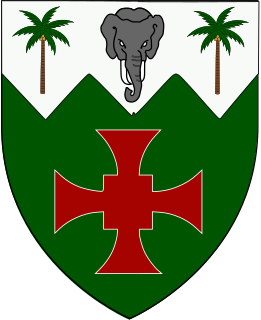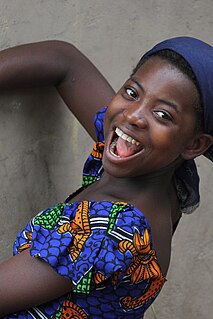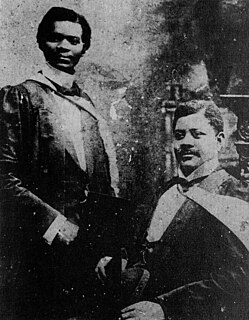Related Research Articles

Sierra Leone, officially the Republic of Sierra Leone, informally Salone, is a country on the southwest coast of West Africa. It is bordered by Liberia to the southeast and Guinea surrounds the northern half of the nation. Sierra Leone has a tropical climate with a diverse environment ranging from savanna to rainforests, a total area of 71,740 km2 (27,699 sq mi) and a population of 7,092,113 as of the 2015 census. The capital and largest city is Freetown. The country is divided into five administrative regions which are subdivided into sixteen districts. Sierra Leone is a constitutional republic with a unicameral parliament and a directly elected president serving a five-year term with a maximum of two terms. The current president is Julius Maada Bio. Sierra Leone is a secular nation with the constitution providing for the separation of state and religion and freedom of conscience. Muslims make up about three-quarters of the population, though with an influential Christian minority. Religious tolerance in the West African nation is very high and is generally considered a norm and part of Sierra Leone's cultural identity.

Bunce Island is an island in the Sierra Leone River. It is situated in Freetown Harbour, the estuary of the Rokel River and Port Loko Creek, about 20 miles upriver from Sierra Leone's capital city Freetown. The island measures about 1,650 feet by 350 feet and houses a castle that was built by the Royal Africa Company in c.1670. Tens of thousands of Africans were shipped from here to the North American colonies of South Carolina and Georgia to be forced into slavery, and are the ancestors of many African Americans of the United States.

Cultural heritage is the legacy of tangible and intangible heritage assets of a group or society that is inherited from past generations. Not all legacies of past generations are "heritage"; rather, heritage is a product of selection by society.

The Antiquities and Monuments Ordinance, in Hong Kong Law, was enacted in 1976 to preserve the objects of historical, archaeological and palaeontological interest and for matters ancillary thereto or connected therewith. It is administered by the Secretary for Home Affairs.

Fourah Bay College is a public university in the neighbourhood of Mount Aureol in Freetown, Sierra Leone. Founded on 18 February 1827, it is the first western-style university built in Sub-Saharan Africa and, furthermore, the first university-level institution in Africa. It is a constituent college of the University of Sierra Leone (USL) and was formerly affiliated with Durham University (1876–1967).

Western Area Peninsula National Park is a protected area in Sierra Leone. It covers an area of 183.37 km².

Joseph A. Opala, OR is an American historian noted for establishing the "Gullah Connection," the historical links between the indigenous people of the West African nation of Sierra Leone and the Gullah people of the Low Country region of South Carolina and Georgia in the United States.
John Joseph Akar (1927–1975) was a Sierra Leonean entertainer, writer, and diplomat. He served as Sierra Leonean ambassador to the United States. Today, he is probably best known for composing the music of Sierra Leone's National Anthem.
The Bagla Hills are located in eastern Sierra Leone within Gola Rainforest National Park, created in 2010, near the border with Liberia. The site has been the subject of controversy between developers and conservationists, as it contains a large iron ore deposit. The Bagla Hills are one of the habitats of the endangered Jentink's duiker.

Cultural properties of Indonesia are those items defined by Indonesian law as of "important value for history, science, and culture", and include both man-made artefacts and natural objects. The cultural properties number more than 8,000 and include ancient Hindu and Buddhist temples, mosques, historic colonial buildings, forts, art galleries, national parks and beaches. A number of the sites are World Heritage Sites.
The National Monuments of Zimbabwe are protected and promoted in accordance with the National Museums and Monuments Act 1972. This law replaced the colonial-era Monuments and Relics Act 1936, which in turn replaced the 1902 Ancient Monuments Protection Ordinance and 1912 Bushmen Relics Ordinance. The National Museums and Monuments of Zimbabwe (NMMZ) is the body responsible for maintaining the Archaeological Survey, the national inventory of monuments and sites. In April 2000 there were approximately 14,000 entries on the Archaeological Survey, of which 118 were National Monuments. 79 National Monuments had been declared under the old system by 1954. By 1980, the register had grown to over 3,000 sites and 169 declared monuments.

Sierra Leone, officially the Republic of Sierra Leone, is a Constitutional Republic in West Africa. Since it was founded in 1787, the women in Sierra Leone have been a major influence in the political and economic development of the nation.

Macormack Charles Farrell Easmon, OBE, popularly known as M. C. F. Easmon or "Charlie", was a Sierra Leone Creole born in Accra in the Gold Coast, where his father John Farrell Easmon, a prominent Creole doctor, was working at the time. He belonged to the notable Easmon family of Sierra Leone, a Creole family of African-American descent.

The Sierra Leone National Museum, previously known as the Sierra Leone Museum and the Museum of the Sierra Leone Society, is the national museum of Sierra Leone. it is located at the junction of Siaka Stevens Street and Pademba Road, in central Freetown.

India–Sierra Leone relations refers to the international relations that exist between India and Sierra Leone. India maintains a High Commission in Freetown. Sierra Leone does not have a resident diplomatic mission in India. The Sierra Leonean embassy in Abu Dhabi, United Arab Emirates is accredited to India.

The Easmon family or the Easmon Medical Dynasty is a Sierra Leone Creole medical dynasty of African-American descent originally based in Freetown, Sierra Leone. The Easmon family has ancestral roots in the United States, and in particular Savannah, Georgia and other states in the American South. There are several descendants of the Sierra Leonean family in the United Kingdom and the United States, as well as in the Ghanaian cities of Accra and Kumasi. The family produced several medical doctors beginning with John Farrell Easmon, the medical doctor who coined the term Blackwater fever and wrote the first clinical diagnosis of the disease linking it to malaria and Albert Whiggs Easmon, who was a leading gynaecologist in Freetown, Sierra Leone. Several members of the family were active in business, academia, politics, the arts including music, cultural dance, playwriting and literature, history, anthropology, cultural studies, and anti-colonial activism against racism.
Heddle's Farm is a national monument in Freetown, Sierra Leone named after Charles Heddle. Before being sold to the Sierra Leonean government in 1878, it belonged to many people who were influential in the area. In 1948, it was proclaimed as a national monument.

David John Francis is a Sierra Leonean politician, academic and author serving as Chief Minister of Sierra Leone from April 2018 to April 2021. He is the first person to hold the office of Chief Minister since it was abolished in 1978. He is widely seen as the most highly influential government official in Sierra Leone, after the president and the vice president.
References
- ↑ "Monuments and Relics Ordinance (1947)" (PDF). UNESCO. Archived from the original (PDF) on 19 September 2015. Retrieved 5 May 2012.
- ↑ "National Monuments". SierraLeoneHeritage.org. Retrieved 5 May 2012.
- ↑ "States Parties – Sierra Leone". UNESCO . Retrieved 5 May 2012.
- ↑ "Tentative Lists – Sierra Leone". UNESCO . Retrieved 5 May 2012.
- ↑ "Exhibition: Reanimating Cultural Heritage in Sierra Leone". Arts and Humanities Research Council. Archived from the original on 19 July 2012. Retrieved 5 May 2012.
- ↑ Basu, Paul (2011). "Object Diasporas, Resourcing Communities: Sierra Leonean Collections in the Global Museumscape" (PDF). Museum Anthropology . American Anthropological Association. 34 (1): 28–42.
- ↑ "SierraLeoneHeritage.org – About". SierraLeoneHeritage.org. Retrieved 5 May 2012.